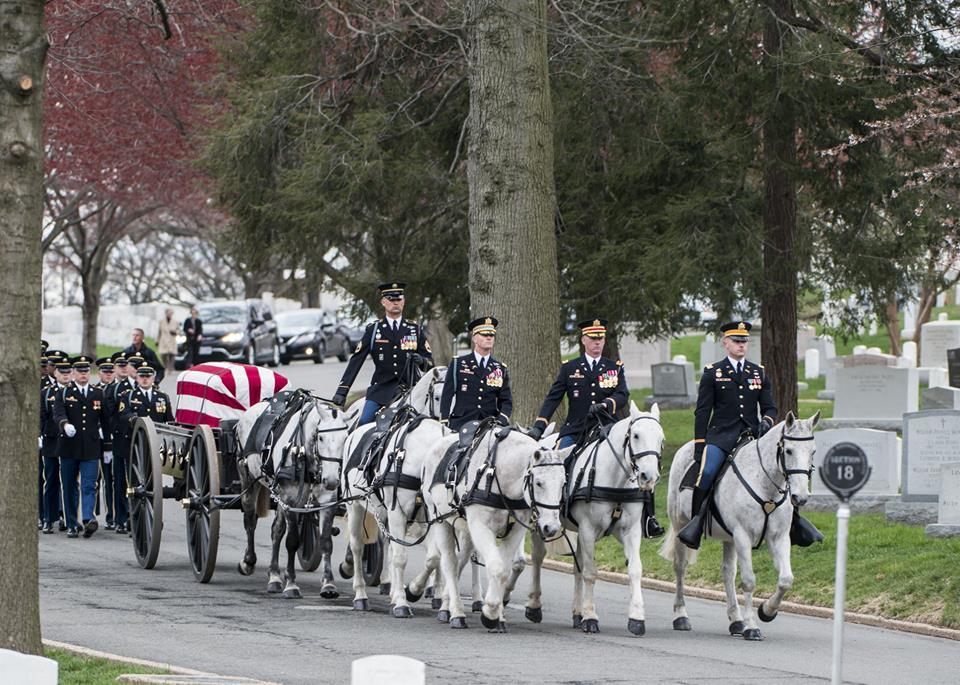
Behind the Scenes With the US Army Caisson & Caparison Platoon
Horse Nation catches up with Spc. Taylor Deivert, MP to learn more about this unique unit and the duties of caisson and caparisoned horses in military funerals. Deivert is believed to be the first female caparison horse handler.
Chances are you’ve seen the U.S. Army’s caisson and caparison units at full honors military funerals at some point. We caught up with Spc. Taylor Deivert, MP, to learn more about the unit and what it’s like to work with these horses.
Horse Nation: What does the Caisson Unit do exactly? I know the caisson itself is what takes the fallen soldier to his or her final resting place, and that the platoon members care for and work with the horses that pull the caisson, correct?
Deivert: The Caisson Platoon conducts full-honor military funerals, a typical day starts at 4-4:30 AM. We get the tack and horses ready, the horses get showers every morning on warmer days, then we dry the horses off with sweat scrapers. We get them tacked up, starting with the saddle blanket, get everything else (breast collar, neck collar, bridle, etc.) on. We hook everything up to the wagon between 7:20 and 7:30, call out is at 7:50, and we check if everyone is ready. We’re wherever we need to be for the funeral 30-40 minutes early, in case the family is early or everything starts early, or there’s a larger procession. When everything is done, it’s usually a 30-40 minute walk back to the barn; we untack the horses, make sure they’re all okay and don’t have any rubs or anything, we change, put the horses away, clean the tack, and make sure everything is ready for the next day. Usually we will be back to the barn around 4 PM, or a bit before. It can be a 12 hour day, minimum; 14 hours is more the average.
HN: The Old Guard is based out of Arlington, VA, correct? Does the unit only work from Arlington?
Deivert: We primarily work from Arlington, though there’s another caisson unit in Houston, TX. For John McCain’s funeral, we took horses to the cathedral and all the way to the cemetery. It was amazing to see how everyone turned out for the funeral; special occasions like that are the only times we’d be outside our normal Arlington duties.
HN: What is your equestrian background?
Deivert: I didn’t grow up around horses; I always loved animals, but moved around a lot. The Caisson Unit prefers people who don’t have any horse background as then we won’t have any bad habits to unlearn. When we join the unit we learn how to work with horses and how to handle them. We learn how they [horses] learn, how they respond to pressure and commands, learn how to tell if their behavior has changed, if they’re stressed or in bad health, everything to make sure that we know how to handle it if something catastrophic happens around the horses. During training, we’re assigned to a horse for eight weeks; one of the horses I trained with was actually a therapy horse. At the end of our training, we go on a trail ride with the whole school before graduation.

Caparison horse, Ronald Reagan’s funeral, photo from US Army Caisson Platoon HHC 1st Bn 3d Inf Regt Facebook page.
HN: Finally, you recently transitioned to doing caparison walks, correct?
Deivert: Yes, I’m the first female anyone’s aware of to do the caparison walks. The routine is different from the Caisson routine: there are three caparison horses, and we come in four hours prior to when they step off for the funeral; for an 11 AM mission, we’re leaving the barn at 10 AM. The horses wear an English saddle with riding boots facing backwards in the stirrups; the boots are attached to the stirrups. The Caparison walk is only for Army and Marine [funerals] as they were the only units that had mounted cavalry.
The boots facing backwards in the stirrups represent the commander’s last stand. The tradition dates back to the Civil and Revolutionary wars; back then, they’d secure the body to the saddle with the boots backwards in the stirrup. The boots would hit the horse on the sides/rear and the horse would run back to camp seeking food, water, and safety. When the horse got back to camp, a lot of times only the boots were left, this turned into a symbol that a unit had lost a commander in battle and needed a new commander on the front lines as soon as possible. This turned into the tradition of walking a caparisoned horse.
Want more? Read our Horses in History: The Caparisoned Horse.








Leave a Comment